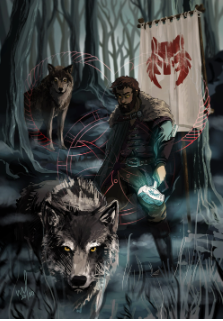Peace de Resistance: On Writing Pacifists
Leaves From The Vine, Falling So Slow….
Stories are defined by their conflicts, dear reader.
A story without conflict is flat, boring, lifeless. When everything is perfect there’s no point reading about it as nothing of note would happen. There would be no fights, debates, inconveniences, nothing.
So, if conflict must exist in order for a story to, focusing on a character who’s primary trait is avoiding conflict seems a poor choice, no? Well, too often you’d be right. Such Pacifist characters tend to be relegated to the background, becoming glorified set dressing as they comment on the events of the story after the fact and acting as the moral compass to the main character in brief vignettes.
Note I say brief as a character who does not engage with the narrative can’t take center state themselves for too long without dragging down the pacing of said narrative.
This is one of the great follies of modern writing, dear reader. You see, Pacifists are indeed difficult to write for the above stated reasons but, if done properly, their stories can be some of the best ever committed to paper.
While stories do indeed live or die based on their conflict, what if its primary conflict focused on the main character’s own aversion to it? Sounds impossible or boring you might say- and hell, I’m not too proud to admit that most times you’d be right. I have, however, seen two different ways where this particular little hat trick has been pulled off masterfully. For your consideration:
The Martyr
This character just wants a life of peace and does their damndest to avoid the central conflict but is dragged into it against their will.
They kick and scream and moan and lament but in the end the villain’s cruelty will force them to stand for those who cannot stand for themselves (bonus points if the Pacifist character is famous for their restraint). They know they have the propensity for violence within them as do all characters, but they keep the beast contained. It is only when the weak and helpless are threatened that the Martyr rises to their feet and lets their own beast off the leash, often with narratively satisfying results.
This character embraces the paradox of fighting for peace and becomes the physical manifestation of the idiom “even demons run when a good man goes to war” while still keeping to their moral code. They sacrifice their own ideals so that those who cannot defend themselves might have them instead.
A prime example of this would be Perrin in The Wheel of Time series (the books not that pox on humanity that is the Amazon production).
Perrin is a bro, dear reader. He just wants to be a blacksmith and make out with his hot girlfriend. 10/10 relatable. When the villains start committing atrocities only he has the power to stop he must abandon his dreams of peace and become the reluctant hero to those who need saving, and all while hating himself for it. It’s fucking great.
I shan’t lie to you: Perrin is one of my favorite characters of all time and I hated him at first. He was the prototypical “oh woe is me” Pacifist character. Once his conflict with conflict BECAME the conflict though he developed into something more complex and quickly became one of the more engrossing characters in a series famed for its cast.
The Purist
This Pacifist embraces the conflict but lets it wash over them rather than allowing it to consume them. They don’t so much resolve or resist the conflict as turn it back on itself to achieve final victory. They refuse to abandon their ideals for any reason whatsoever, even to the perceived detriment of those around them.
Where the Martyr may resolve to face the conflict on their own terms the Purist refuses, often being cornered into doing so by circumstance rather than choice. This character must be smarter and faster than those around them in order to facilitate a peaceful resolution in the face of insurmountable and often cataclysmic odds.
For an excellent example look no further than Aang from Avatar: The Last Airbender. Aang’s whole thing is that he’s a peace loving monk (and just a kid) who is forced into fighting a power hungry maniac for the fate of the world.
As the climactic battle approaches everyone (even the villain’s son) assures him that killing the big bad is the only way to win but Aang doesn’t want to take a life. He seeks every avenue out of this fate he can think of, discussing alternate plans with his friends and even consulting with the spirits of his past lives (as one does) to gain advice from those with decades more experience. Even then, however, the past lives who share his ideals regretfully tell them this is bigger than himself and that he owes it to the world to do what must be done.
But Aang doesn’t break. Hell, he doesn’t even bend. When facing the villain he tries avoiding a fight altogether and when his inner power displays itself and sends him on a kind of “auto pilot/terminator mode” he masters it before it can deliver the killing blow and gives the villain another chance to peacefully resolve things. When the villain attempts a cheap shot Aang turns his violence against him and enters into a battle of wills where his own convictions are what lead to a peaceful resolution and a new golden age of harmony in the world.
The Last Airbender is a stellar example of writing all around (power systems, levels, character development, the works) but this final scene is a perfect culmination of how a character who hates fighting, must.
Those are just two examples, mind you. One is more human, the other more impressive, but both share the belief that the pursuit of peace is not weakness and that the easy answer isn’t always the best.
Pacifists do tend to be boring, dear reader, but they certainly don’t have to be.
So what do you think? Are there any more archetypes or examples you can think of? Sound off below or shoot me any email to discuss. I’m always open to chat!

